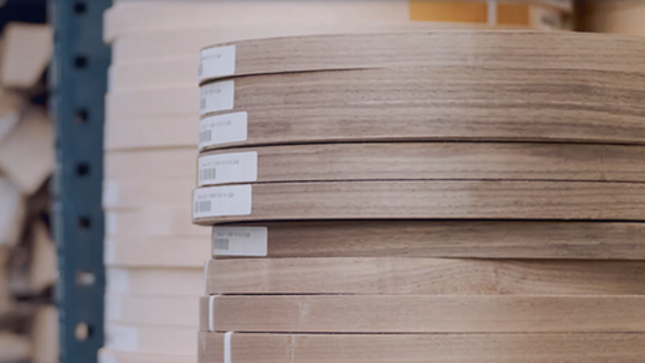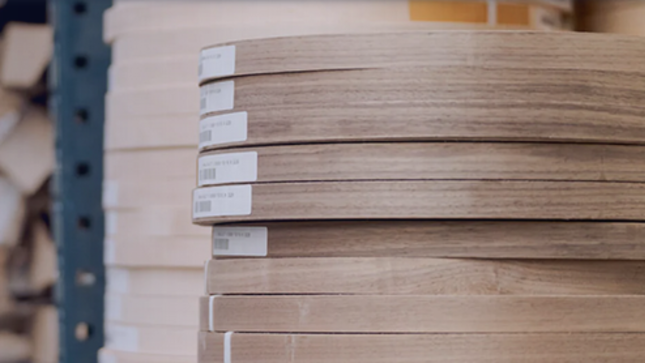
In the world of custom furniture design, details matter. One of the most important aspects of achieving a polished, high-quality finish is the choice of edge banding. PVC and veneer edge banding are two popular options, each offering unique benefits and characteristics. Understanding when to use PVC versus veneer edgebanding can make all the difference in the final look, durability, and cost of your project.
Understanding Edgebanding: The Basics
Edgebanding is a thin strip of material applied to the exposed edges of furniture panels, particularly those made of plywood, particleboard, or MDF. It serves both aesthetic and functional purposes, covering the raw edges to create a smooth, finished appearance while also protecting the edges from damage and moisture.
PVC Edgebanding is made from polyvinyl chloride, a type of plastic that is highly durable and versatile. It is available in a wide range of colors, textures, and finishes, making it a popular choice for both residential and commercial furniture.
Veneer Edgebanding, on the other hand, is made from real wood. It provides a natural, authentic wood finish, often used in high-end furniture pieces to match or complement wood veneers on the surface panels.
When to Use PVC Edgebanding
1. Durability and Wear Resistance
a. High-Traffic Areas: If your furniture is intended for high-traffic areas, such as offices, schools, or retail spaces, PVC edge banding is an excellent choice. It’s resistant to impact, moisture, and general wear and tear, ensuring longevity even in demanding environments.
b. Moisture-Prone Environments: PVC edgebanding is ideal for furniture in kitchens, bathrooms, or other areas where moisture exposure is a concern. Its non-porous surface prevents water absorption, reducing the risk of swelling or damage.
2. Versatility in Design
a. Modern and Contemporary Aesthetics: PVC edgebanding offers a wide variety of colors and finishes, including solid colors, metallics, and woodgrain patterns. This makes it perfect for modern, minimalist designs where a uniform, clean look is desired.
b. Cost-Effective Customization: If you’re working within a budget but still want to achieve a customized look, PVC edgebanding allows you to experiment with different styles without breaking the bank. It’s also easier to match with other synthetic materials, making it a flexible option for various design schemes.
3. Ease of Maintenance
a. Low-Maintenance Needs: PVC is easy to clean and maintain, requiring minimal effort to keep it looking new. This makes it a practical choice for furniture that will see heavy use or requires frequent cleaning.
When to Use Veneer Edgebanding
1. High-End, Natural Aesthetics
a. Authentic Wood Finish: If you’re aiming for a luxurious, high-end look, veneer edgebanding is the way to go. It provides the warmth and natural beauty of real wood, which can’t be perfectly replicated by synthetic materials.
a. Matching with Wood Veneer Panels: When using wood veneer panels for the main surfaces, veneer edge banding ensures a seamless, cohesive look. It’s especially important in high-end furniture where attention to detail is critical.
2. Traditional and Classic Designs
a. Timeless Appeal: Veneer edgebanding is well-suited for traditional and classic furniture designs. The natural variations in wood grain add character and depth, making it a popular choice for cabinetry, dining tables, and other fine furniture pieces.
b. Custom Staining and Finishing: Unlike PVC, veneer edgebanding can be stained, varnished, or finished to match the exact color and sheen of the surrounding wood surfaces. This level of customization is ideal for bespoke furniture projects where precise color matching is essential.
3. Sustainability Considerations
a. Eco-Friendly Option: For those concerned with sustainability, veneer edgebanding made from responsibly sourced wood is a more eco-friendly option. It’s biodegradable and has a lower environmental impact compared to plastic-based edgebanding.
Making the Right Choice for Your Project
When deciding between PVC and veneer edgebanding, consider the following factors:
● Intended Use: Is the furniture for a high-traffic area or a moisture-prone environment? PVC might be the better choice for durability.
● Design Style: Are you aiming for a modern, sleek look or a traditional, natural finish? Your design vision will guide your choice.
● Budget: While both options are cost-effective, PVC offers more affordable customization, while veneer may be worth the investment for a high-end project.
● Maintenance Needs: If ease of maintenance is a priority, PVC’s low-maintenance properties might be preferable.
● Sustainability: If environmental impact is a concern, consider veneer edgebanding from sustainable sources.
Both PVC and veneer edgebanding have their unique advantages. By carefully considering the needs of your project, you can select the edgebanding material that best suits your aesthetic goals, functional requirements, and budget, ensuring a beautifully finished piece of furniture that stands the test of time.

